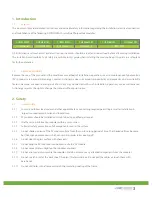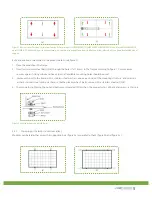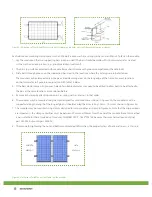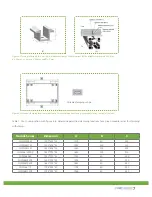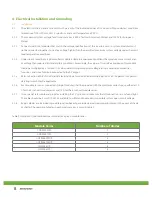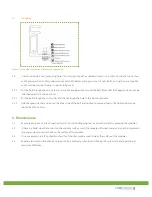
8
4. Electrical Installation and Grounding
4.1 Installation
4.1.1
The electrical characteristics are within ±10 percent of the indicated values of Isc. Voc and Pmp under test conditions
(irradiance of 100 mW/cm2,AM1.5 spectrum, and a cell temperature of 25°C).
4.1.2
The maximum system voltage for all module series is 600 V for North American Market and 1000V for European
Market.
4.1.3
Connect quantity of modules that match the voltage specifications of the inverters used in system. Modules must
not be connected together to create a voltage higher than the permitted maximum system voltage under the worst
local temperature conditions.
4.1.4
Under normal conditions, a photovoltaic module is likely to experience conditions that produce more current and/
or voltage than reported at standard test conditions. Accordingly, the values of Isc and Voc marked on this module
should be multiplied by a factor of 1.25 when determining component voltage ratings, conductor ampacities,
fuse sizes, and size of controls connected to the PV output.
4.1.5
Refer to Section 690-8 of the National Electrical Code for an additional multiplying factor of 125 percent (80 percent
derating) which may be applicable.
4.1.6
Each module (or series-connected string of modules) shall be provided with the maximum series fuse, specified as 10
A for the 5 inch cell module series and 15 A for the 6 inch cell module series.
4.1.7
Use a special solar cable and plugs for installing the PV system and make sure that all connections are safe and tight.
The cable should be 4 mm2 (12 AWG), and able to withstand the maximum possible system open-circuit voltage.
4.1.8
Bypass diodes are included in module junction boxes to avoid decreased module performance in the event of shade
or shelter. The number of diodes in each module series is given in table 2.
Table 2. Number of junction-box bypass diodes for a given module series.
Module Series
Number of diodes
CHSM 5409M
3
CHSM 5612M
3
CHSM 6609M/P
6
CHSM 6610M/P
6
CHSM 6611P
6
CHSM 6612P
6



